Data Elements and Agricultural Green Total Factor Productivity: Evidence from a Quasi-Natural Experiment Based on Public Data Openness in China
Abstract
1. Introduction
2. Theoretical Analysis and Research Hypotheses
2.1. The Effects of Public Data Openness on AGTFP
2.2. The Mechanism of Public Data Openness on AGTFP
2.2.1. Data Openness, Cross-Sectoral Labor Transfer, and AGTFP
2.2.2. Public Data Openness, Green Technological Innovation, and AGTFP
3. Data, Variables, and Methods
3.1. Data Sources
3.2. Variables
3.2.1. The Dependent Variable: AGTFP
3.2.2. The Independent Variable: Public Data Openness (DATA)
3.2.3. Control Variables
3.3. Model
3.3.1. Baseline Model
3.3.2. Mediation Effects Model
4. Results
4.1. Baseline Regression
4.2. Robustness Checks
4.2.1. Parallel Trends Test
4.2.2. Placebo Test
4.2.3. Replacing the Dependent Variable
4.2.4. Adjusting the Sample Time Period
4.2.5. Propensity Score Matching (PSM) Approach
4.2.6. Winsorization
4.3. Further Analyses
4.3.1. Mediating Mechanism Analysis
4.3.2. Heterogeneity Analysis
- (1)
- Heterogeneity in Environmental Regulation
- (2)
- Heterogeneity in Production Structure
5. Conclusions and Implications
5.1. Conclusions
5.2. Implications
Author Contributions
Funding
Institutional Review Board Statement
Data Availability Statement
Conflicts of Interest
References
- Su, Y.; He, S.; Wang, K.; Shahtahmassebi, A.R.; Zhang, L.; Zhang, J.; Zhang, M.; Gan, M. Quantifying the sustainability of three types of agricultural production in China: An emergy analysis with the integration of environmental pollution. J. Clean. Prod. 2020, 252, 119650. [Google Scholar] [CrossRef]
- Xue, Y.; Tang, C.; Wu, H.; Liu, J.; Hao, Y. The emerging driving force of energy consumption in China: Does digital economy development matter? Energy Policy 2022, 165, 112997. [Google Scholar] [CrossRef]
- Li, D.; Gui, M.; Ma, R.; Feng, Y. Public data accessibility and corporate maturity mismatch: Evidence from China. Pac.-Basin Financ. J. 2024, 86, 102455. [Google Scholar] [CrossRef]
- Falavigna, G.; Manello, A.; Pavone, S. Environmental efficiency, productivity and public funds: The case of the Italian agricultural industry. Agric. Syst. 2013, 121, 73–80. [Google Scholar] [CrossRef]
- Murillo, Z.L.R. Economic efficiency and frontier techniques. J. Econ. Surv. 2004, 18, 33–77. [Google Scholar] [CrossRef]
- Guo, H.; Liu, X. Time-space evolution of China’s agricultural green total factor productivity. Chin. J. Manag. Sci. 2020, 28, 66–75. [Google Scholar] [CrossRef]
- Wang, H.; Tang, Y. Spatiotemporal Distribution and Influencing Factors of Coupling Coordination between Digital Village and Green and High-Quality Agricultural Development—Evidence from China. Sustainability 2023, 15, 8079. [Google Scholar] [CrossRef]
- Lu, X.; Jiang, X.; Gong, M. How land transfer marketization influence on green total factor productivity from the approach of industrial structure? Evidence from China. Land Use Policy 2020, 95, 104610. [Google Scholar] [CrossRef]
- Ge, J.; Zhou, S. Whether factor market distortions stimulate agricultural surface pollution—The case of fertilizers. Agric. Econ. 2021, 33, 92–98+112. (In Chinese) [Google Scholar] [CrossRef]
- Fang, J.; Liu, Y.; Gao, H. Can public data openness promote coordinated regional development?—A quasi-natural experiment from the launch of a government data platform. J. Manag. World 2023, 39, 124–142. (In Chinese) [Google Scholar] [CrossRef]
- Young, A.; Verhulst, S. The Global Impact of Open Data; O’Reilly Media, Incorporated: Sebastopol, CA, USA, 2016. [Google Scholar]
- Laursen, K.; Salter, A. Open for innovation: The role of openness in explaining innovation performance among UK manufacturing firms. Strateg. Manag. J. 2006, 27, 131–150. [Google Scholar] [CrossRef]
- Nagaraj, A. The private impact of public data: Landsat satellite maps increased gold discoveries and encouraged entry. Manag. Sci. 2022, 68, 564–582. [Google Scholar] [CrossRef]
- Gao, Q.; Cheng, C.; Sun, G.; Li, J. The impact of digital inclusive finance on agricultural green total factor productivity: Evidence from China. Front. Ecol. Environ. 2022, 10, 905644. [Google Scholar] [CrossRef]
- Jiang, Q.; Li, J.; Si, H.; Su, Y. The impact of the digital economy on agricultural green development: Evidence from China. Agriculture 2022, 12, 1107. [Google Scholar] [CrossRef]
- Shen, Z.; Wang, S.; Boussemart, J.-P.; Hao, Y. Digital transition and green growth in Chinese agriculture. Technol. Forecast. Soc. Change 2022, 181, 121742. [Google Scholar] [CrossRef]
- Peng, Z.; Dan, T. Digital dividend or digital divide? Digital economy and urban-rural income inequality in China. Telecommun. Policy 2023, 47, 102616. [Google Scholar] [CrossRef]
- Xie, K.; Yi, F.; Gu, F. Big data-driven agricultural digital transformation and innovation. Issues Agric. Econ. 2022, 5, 37–48. (In Chinese) [Google Scholar] [CrossRef]
- dos Santos Gaspar, J.; Marques, A.C.; Fuinhas, J.A. The traditional energy-growth nexus: A comparison between sustainable development and economic growth approaches. Ecol. Indic. 2017, 75, 286–296. [Google Scholar] [CrossRef]
- Lin, Y.; Habib, A. Quality control and crop characterization framework for multi-temporal UAV LiDAR data over mechanized agricultural fields. Remote Sens. Environ. 2021, 256, 112299. [Google Scholar] [CrossRef]
- Hong, J.; Shi, F.; Zheng, Y. Does network infrastructure construction reduce energy intensity? Based on the “Broadband China” strategy. Technol. Forecast. Soc. Change 2023, 190, 122437. [Google Scholar] [CrossRef]
- Lei, S.; Yang, X.; Qin, J. Does agricultural factor misallocation hinder agricultural green production efficiency? Evidence from China. Sci. Total Environ. 2023, 891, 164466. [Google Scholar] [CrossRef] [PubMed]
- Liu, S.; Zhang, X. Digital infrastructure and food production: Empirical evidence based on deep learning. Quant. Econ. Tech. Econ. Res. 2024, 41, 155–176. (In Chinese) [Google Scholar] [CrossRef]
- Zhao, S. Institutional Regulation of Revenue Distribution from Government Open Data in the Context of Common Prosperity. E-Government 2023, 4, 80–92. (In Chinese) [Google Scholar] [CrossRef]
- Wang, S.; Tang, J.; Liu, D. The impact of government data openness on labor employment: A dual perspective based on employment scale and employment structure. East China Econ. Manag. 2024, 38, 116–128. (In Chinese) [Google Scholar] [CrossRef]
- Liu, X.; Lu, F. The puzzle of rising capital returns in China. China Econ. Q. 2014, 13, 817–836. (In Chinese) [Google Scholar] [CrossRef]
- Yao, S.; Guo, Y.; Huo, X. An empirical analysis of the effects of China’s land conversion program on farmers’ income growth and labor transfer. Environ. Manag. 2010, 45, 502–512. [Google Scholar] [CrossRef]
- Rahman, M. The virtuous circle between green product innovation and performance: The role of financial constraint and corporate brand. J. Bus. Res. 2023, 154, 113296. [Google Scholar] [CrossRef]
- Song, M.; Fisher, R.; Kwoh, Y. Technological challenges of green innovation and sustainable resource management with large scale data. Technol. Forecast. Soc. Change 2019, 144, 361–368. [Google Scholar] [CrossRef]
- Zhong, R.; He, Q.; Qi, Y. Digital economy, agricultural technological progress, and agricultural carbon intensity: Evidence from China. Int. J. Environ. Res. Public Health 2022, 19, 6488. [Google Scholar] [CrossRef]
- Sayer, J.; Cassman, K.G. Agricultural innovation to protect the environment. Proc. Natl. Acad. Sci. USA 2013, 110, 8345–8348. [Google Scholar] [CrossRef]
- Tone, K. A slacks-based measure of super-efficiency in data envelopment analysis. Eur. J. Oper. Res. 2002, 143, 32–41. [Google Scholar] [CrossRef]
- Li, L.; Shi, P. A study on the impact of carbon finance effects on regional carbon emission based on the LMDI model. Stat. Decis. 2018, 34, 164–167. (In Chinese) [Google Scholar] [CrossRef]
- Zhang, J.; He, K. Research on Low-Carbon Agricultural Development under the “Dual Carbon” Goals: Current Status, Misunderstandings, and Prospects. Agric. Econ. Issues 2022, 2022, 35–46. (In Chinese) [Google Scholar] [CrossRef]
- Lai, S.; Du, P.; Chen, J. Non-Point Source Pollution Survey and Assessment Method Based on Unit Analysis. J. Tsinghua Univ. Nat. Sci. Ed. 2004, 2004, 1184–1187. (In Chinese) [Google Scholar] [CrossRef]
- Oh, D.-H. A global Malmquist-Luenberger productivity index. J. Product. Anal. 2010, 34, 183–197. [Google Scholar] [CrossRef]
- Wang, F.; Du, L.; Tian, M. Does agricultural credit input promote agricultural green total factor productivity? Evidence from spatial panel data of 30 provinces in China. Int. J. Environ. Res. Public Health 2022, 20, 529. [Google Scholar] [CrossRef]
- Beck, T.; Levine, R.; Levkov, A. Big bad banks? The winners and losers from bank deregulation in the United States. J. Financ. 2010, 65, 1637–1667. [Google Scholar] [CrossRef]
- Cai, X.; Lu, Y.; Wu, M.; Yu, L. Does environmental regulation drive away inbound foreign direct investment? Evidence from a quasi-natural experiment in China. J. Dev. Econ. 2016, 123, 73–85. [Google Scholar] [CrossRef]
- Hadi-Vencheh, A.; Foroughi, A.A. A generalized DEA model for inputs/outputs estimation. Math. Comput. Model. 2006, 43, 447–457. [Google Scholar] [CrossRef]
- Luo, C.; Teng, Y.; Li, L. Industry structure, gender discrimination, and the gender wage gap. J. Manag. World 2019, 35, 58–68 (In Chinese). [Google Scholar] [CrossRef]
- Kesidou, E.; Wu, L. Stringency of environmental regulation and eco-innovation: Evidence from the eleventh Five-Year Plan and green patents. Econ. Lett. 2020, 190, 109090. [Google Scholar] [CrossRef]
- He, Y.; Luo, Q. Environmental regulation, technological innovation, and industrial total factor productivity: A re-examination of the “strong Porter hypothesis”. Soft Sci. 2018, 32, 20–25. (In Chinese) [Google Scholar] [CrossRef]
- Zhao, H.; Pan, G. A study on the coupling and coordination between digital finance and high-quality agricultural development in the Yellow River Basin. Stat. Decis. 2024, 40, 152–157. (In Chinese) [Google Scholar] [CrossRef]
- Deng, H.; Zheng, W.; Shen, Z.; Štreimikienė, D. Does fiscal expenditure promote green agricultural productivity gains: An investigation on corn production. Appl. Energy 2023, 334, 120666. [Google Scholar] [CrossRef]
- Zhou, J.; Xu, N.; Zhang, W.; Ning, X. Can agricultural low-carbon development benefit from urbanization?—Empirical evidence from China’s new-type urbanization pilot policy. J. Clean. Prod. 2024, 435, 140388. [Google Scholar] [CrossRef]
- Sun, Y. Environmental regulation, agricultural green technology innovation, and agricultural green total factor productivity. Front. Environ. Sci. 2022, 10, 955954. [Google Scholar] [CrossRef]
- Ye, T.; Zhang, Y.; Wang, X. Does digital economy service industry improve regional green innovation efficiency?—A dual perspective based on industrial collaborative agglomeration and public environmental concern. Econ. Manag. Res. 2025, 46, 45–60. (In Chinese) [Google Scholar] [CrossRef]
- Guo, Z.; Chen, X.; Zhang, Y. Impact of environmental regulation perception on farmers’ agricultural green production technology adoption: A new perspective of social capital. Technol. Soc. 2022, 71, 102085. [Google Scholar] [CrossRef]
- Liu, D.; Zhu, X.; Wang, Y. China’s agricultural green total factor productivity based on carbon emission: An analysis of evolution trend and influencing factors. J. Clean. Prod. 2021, 278, 123692. [Google Scholar] [CrossRef]
- Zhu, J.; Zhu, Z.; Zhang, B. Can the construction of agricultural industrial parks enhance food production resilience?—A quasi-natural experiment based on national modern agricultural demonstration areas. World Agric. 2025, 03, 119–131. (In Chinese) [Google Scholar] [CrossRef]
- Ma, G.; Tan, Y. A study on the impact of environmental regulation on agricultural green total factor productivity—An analysis based on the panel threshold model. Agric. Technol. Econ. 2021, 05, 77–92. (In Chinese) [Google Scholar] [CrossRef]
- Guo, Y.; Yan, J.; Zhuang, P. How does data sharing affect the sustainable development of agribusiness? Evidence from public data openness. Int. Rev. Econ. Financ. 2025, 97, 103785. [Google Scholar] [CrossRef]
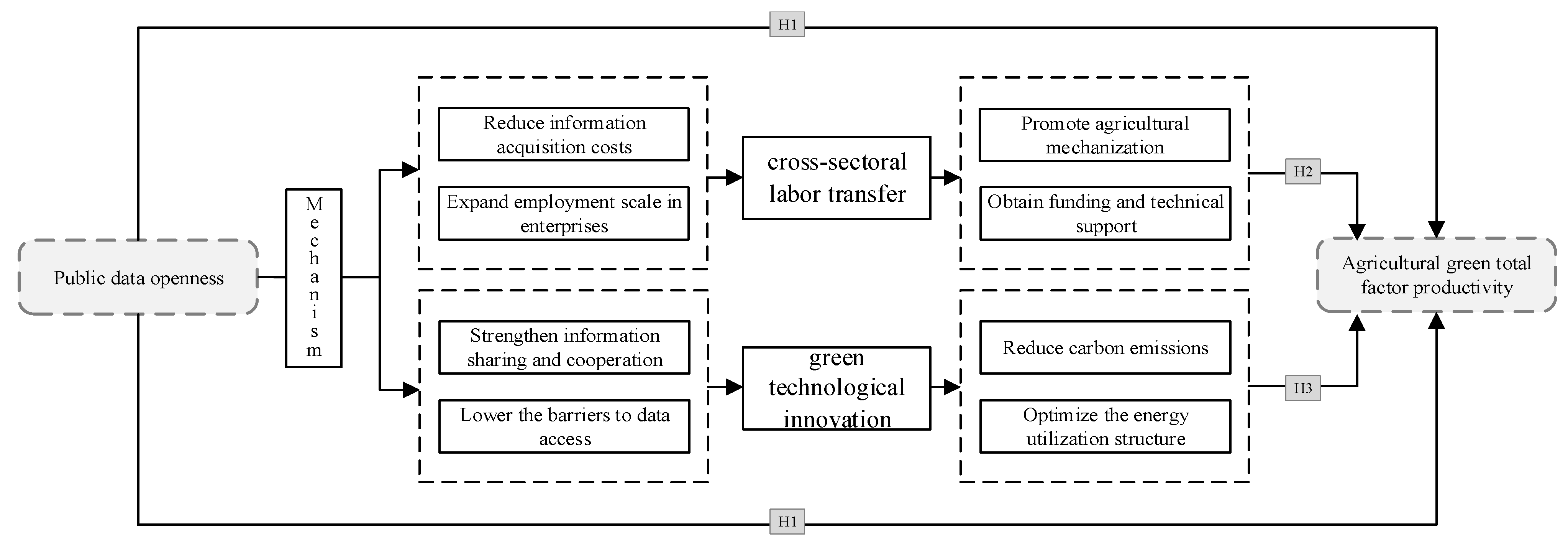

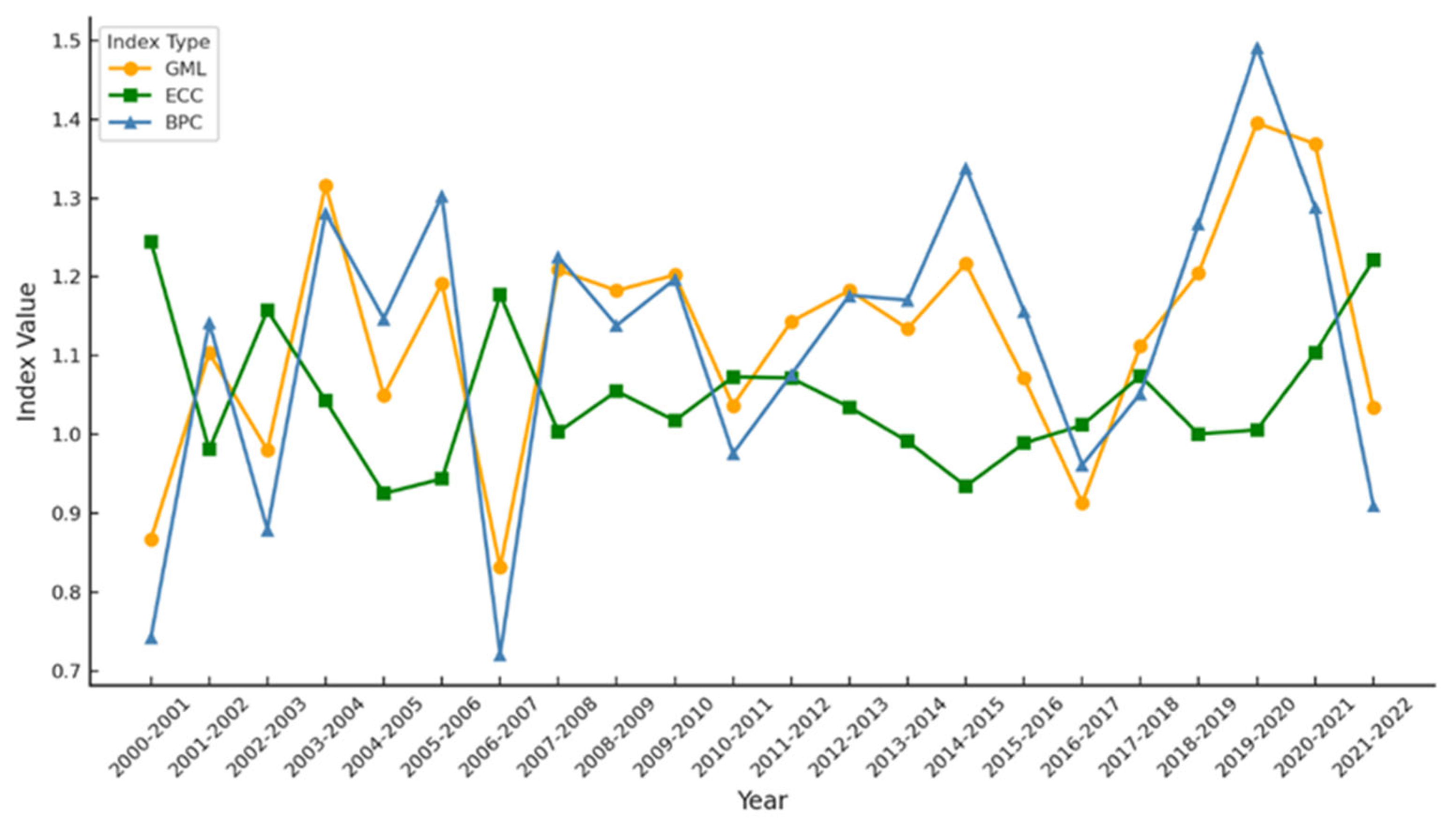
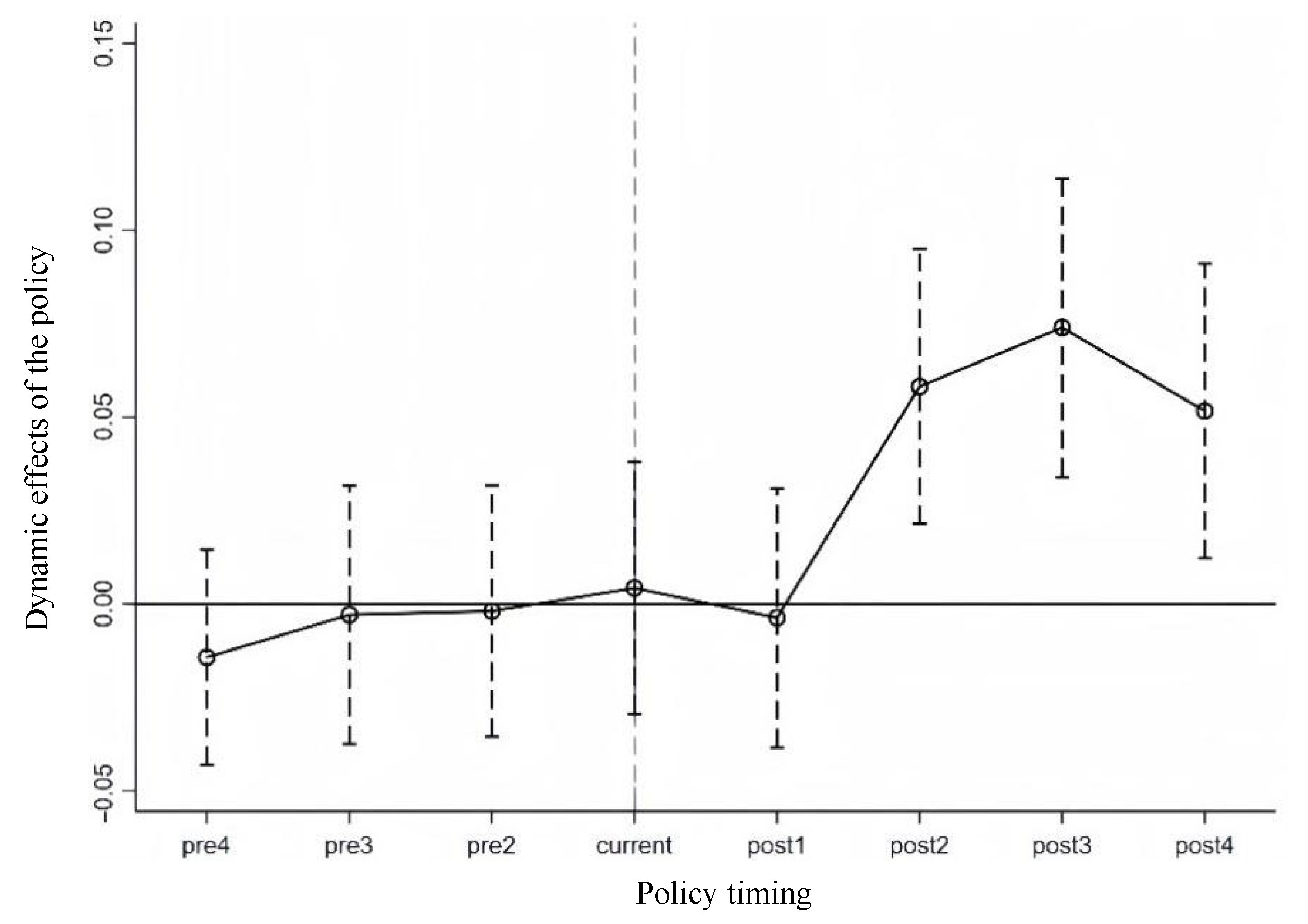
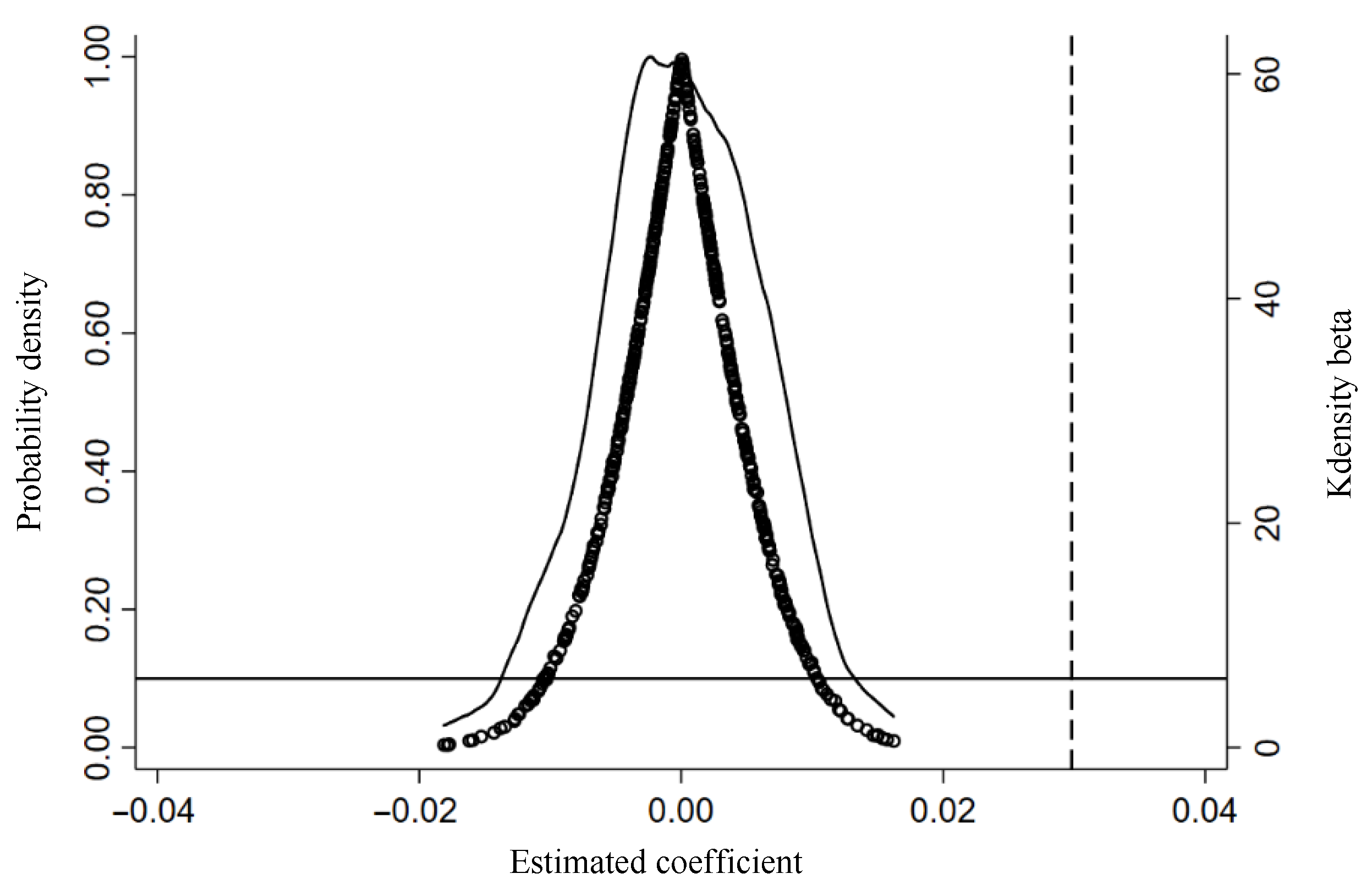
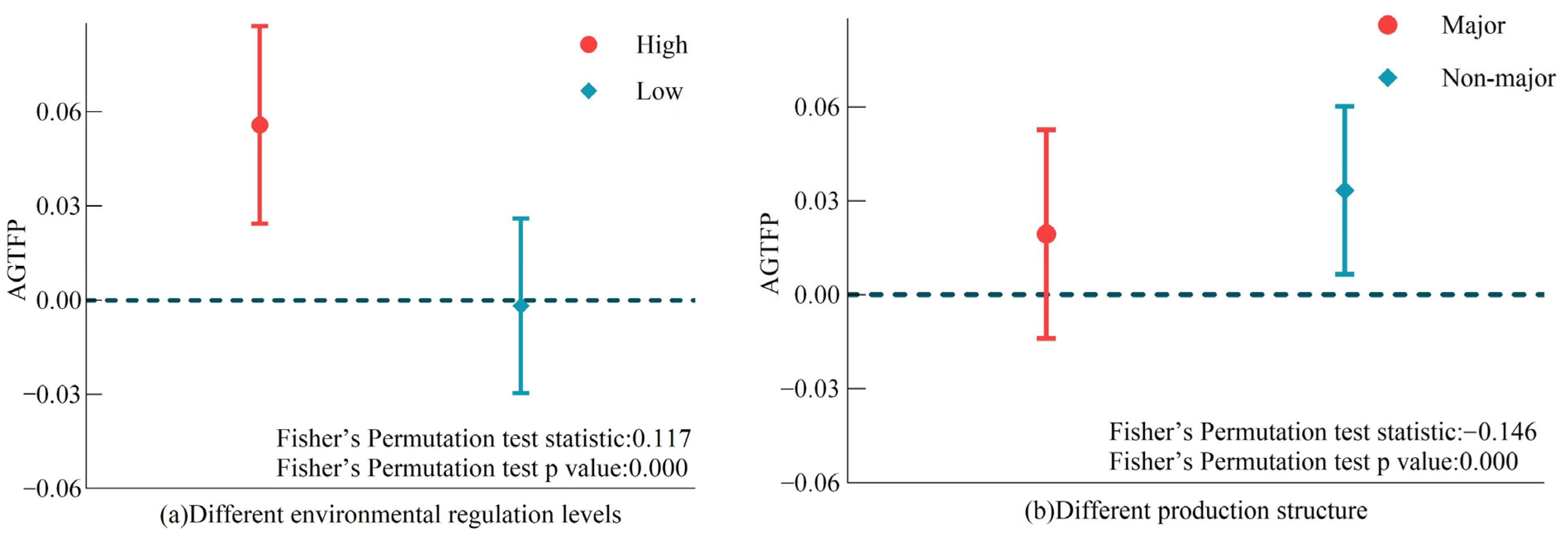
| Indicator | Specific Indicators | Indicator Measurement | Unit | Mean | S.D. |
|---|---|---|---|---|---|
| Inputs | Labor input | Number of agricultural workers | 10,000 people | 905.17 | 681.10 |
| Land input | Crop sown area | thousand hectares | 5364.65 | 3639.25 | |
| Capital input | Total power of agricultural machinery | 10,000 kilowatts | 2909.93 | 2725.78 | |
| Agricultural fertilizer use (pure) | 10 kilo-tons | 174.77 | 136.64 | ||
| Resource input | Crop irrigated area | thousand hectares | 2027.31 | 1540.65 | |
| Outputs | Expected output | Total agricultural output value | 100 million yuan | 1403.79 | 1284.72 |
| Unexpected output | Agricultural carbon emissions | 10 kilo-tons | 310.97 | 223.35 | |
| Nitrogen and phosphorus emissions | 10 kilo-tons | 69.59 | 61.32 |
| Year | Province/Municipality |
|---|---|
| 2012 | Beijing, Shanghai |
| 2015 | Zhejiang Province |
| 2016 | Guangdong Province, Guizhou Province |
| 2018 | Jiangxi Province, Shandong Province, Henan Province, Shaanxi Province, Ningxia Hui Autonomous Region |
| 2019 | Tianjin, Jiangsu Province, Fujian Province, Hainan Province, Sichuan Province, Xinjiang Uyghur Autonomous Region, Qinghai Province |
| 2020 | Hubei Province, Hunan Province, Chongqing, Guangxi Zhuang Autonomous Region |
| 2021 | Gansu Province, Anhui Province, Hebei Province |
| Variable Type | Variable | Variable Definition | Obs | Mean | S.D. |
|---|---|---|---|---|---|
| Dependent Variable | AGTFP | Super Efficiency SBM model calculation | 690 | 0.532 | 0.158 |
| Independent Variable | DATA | Whether each province has implemented: yes = 1; no = 0 | 690 | 0.167 | 0.373 |
| Control Variable | TRAN | Number of road kilometers, density | 690 | 11.399 | 0.919 |
| URB | Urban population/total population | 690 | 0.516 | 0.151 | |
| AML | Agricultural machinery horsepower per unit area | 690 | 0.560 | 0.259 | |
| HUM | Higher education student population/total population | 690 | 0.017 | 0.007 | |
| AD | disaster-affected crop area/crop sowing area | 690 | 0.225 | 0.16 | |
| FIN | General fiscal government expenditure/GDP | 690 | 0.209 | 0.096 |
| Variables | (1) | (2) |
|---|---|---|
| DATA | 0.0189 * | 0.0298 *** |
| (1.8871) | (2.8853) | |
| TRAN | 0.0370 ** | |
| (2.2906) | ||
| URB | −0.0247 | |
| (−0.7319) | ||
| AML | −0.0529 ** | |
| (−1.9985) | ||
| HUM | 3.0113 *** | |
| (2.7007) | ||
| AD | −0.0580 *** | |
| (−2.6723) | ||
| FIN | 0.0930 | |
| (1.2313) | ||
| Province fixed effects | Yes | Yes |
| Year fixed effects | Yes | Yes |
| Constant | 0.3880 *** (35.5148) | 0.0206 (0.1233) |
| Pseudo R2 | 0.827 | 0.833 |
| N | 690 | 690 |
| Variables | (1) | (2) | (3) | (4) |
|---|---|---|---|---|
| DATA | 0.1061 *** | 0.0145 ** | 0.0283 *** | 0.0278 *** |
| (7.1167) | (1.9869) | (2.7161) | (2.7930) | |
| TRAN | 0.0111 | 0.0936 *** | 0.0452 *** | 0.0366 ** |
| (0.4758) | (2.8422) | (2.8413) | (2.3479) | |
| URB | 0.1128 ** | 0.0568 | −0.0119 | −0.0263 |
| (2.3170) | (1.0943) | (−0.3481) | (−0.8087) | |
| AML | 0.0280 | −0.0529 *** | −0.0560 ** | −0.0626 ** |
| (0.7326) | (−2.8924) | (−2.0457) | (−2.4539) | |
| HUM | 2.4950 | 4.1570 *** | 1.9669 * | 2.9857 *** |
| (1.5519) | (3.1278) | (1.7177) | (2.7815) | |
| AD | −0.0573 * | −0.0294 ** | −0.0606 *** | −0.0561 *** |
| (−1.8327) | (−2.0096) | (−2.7166) | (−2.6875) | |
| FIN | −0.0585 | 0.0740 | 0.0820 | 0.0929 |
| (−0.5371) | (0.9660) | (1.0586) | (1.2768) | |
| Province fixed effects | Yes | Yes | Yes | Yes |
| Year fixed effects | Yes | Yes | Yes | Yes |
| Constant | 0.0605 (0.2516) | −0.6928 * (−1.8785) | −0.0625 (−0.3771) | 0.0298 (0.1858) |
| Pseudo R2 | 0.861 | 0.834 | 0.833 | 0.841 |
| N | 690 | 330 | 690 | 690 |
| Variables | CSLT | AGTFP | GTI | AGTFP |
|---|---|---|---|---|
| (1) | (2) | (3) | (4) | |
| DATA | 0.0381 *** | 0.0175 * | 0.2258 *** | 0.0259 ** |
| (5.9734) | (1.6801) | (4.5825) | (2.4726) | |
| CSLT | 0.3237 *** | |||
| (5.1106) | ||||
| GTI | 0.0173 ** | |||
| (2.0805) | ||||
| TRAN | 0.0440 *** | 0.0228 | 0.2496 *** | 0.0327 ** |
| (4.4174) | (1.4153) | (3.2400) | (2.0117) | |
| URB | 0.0790 *** | −0.0503 | 0.9232 *** | −0.0407 |
| (3.8000) | (−1.5023) | (5.7432) | (−1.1791) | |
| AML | 0.0429 *** | −0.0668 ** | 0.2304 * | −0.0569 ** |
| (2.6300) | (−2.5590) | (1.8258) | (−2.1493) | |
| HUM | 5.6476 *** | 1.1831 | 13.4644 ** | 2.7778 ** |
| (8.2179) | (1.0284) | (2.5354) | (2.4852) | |
| AD | 0.0162 | −0.0632 *** | 0.1545 | −0.0606 *** |
| (1.2096) | (−2.9676) | (1.4958) | (−2.7983) | |
| FIN | −0.0311 | 0.1031 | −0.0217 | 0.0934 |
| (−0.6671) | (1.3908) | (−0.0602) | (1.2395) | |
| Province fixed effects | Yes | Yes | Yes | Yes |
| Year fixed effects | Yes | Yes | Yes | Yes |
| Constant | −0.0438 | 0.0347 | 0.5390 | 0.0112 |
| (−0.4258) | (0.2123) | (0.6786) | (0.0674) | |
| Pseudo R2 | 0.835 | 0.840 | 0.970 | 0.834 |
| N | 690 | 690 | 690 | 690 |
Disclaimer/Publisher’s Note: The statements, opinions and data contained in all publications are solely those of the individual author(s) and contributor(s) and not of MDPI and/or the editor(s). MDPI and/or the editor(s) disclaim responsibility for any injury to people or property resulting from any ideas, methods, instructions or products referred to in the content. |
© 2025 by the authors. Licensee MDPI, Basel, Switzerland. This article is an open access article distributed under the terms and conditions of the Creative Commons Attribution (CC BY) license (https://creativecommons.org/licenses/by/4.0/).
Share and Cite
Ren, J.; Wang, M.; Li, X.; Ding, X. Data Elements and Agricultural Green Total Factor Productivity: Evidence from a Quasi-Natural Experiment Based on Public Data Openness in China. Agriculture 2025, 15, 1130. https://doi.org/10.3390/agriculture15111130
Ren J, Wang M, Li X, Ding X. Data Elements and Agricultural Green Total Factor Productivity: Evidence from a Quasi-Natural Experiment Based on Public Data Openness in China. Agriculture. 2025; 15(11):1130. https://doi.org/10.3390/agriculture15111130
Chicago/Turabian StyleRen, Jiazhen, Min Wang, Xiaojing Li, and Xiaoyu Ding. 2025. "Data Elements and Agricultural Green Total Factor Productivity: Evidence from a Quasi-Natural Experiment Based on Public Data Openness in China" Agriculture 15, no. 11: 1130. https://doi.org/10.3390/agriculture15111130
APA StyleRen, J., Wang, M., Li, X., & Ding, X. (2025). Data Elements and Agricultural Green Total Factor Productivity: Evidence from a Quasi-Natural Experiment Based on Public Data Openness in China. Agriculture, 15(11), 1130. https://doi.org/10.3390/agriculture15111130






